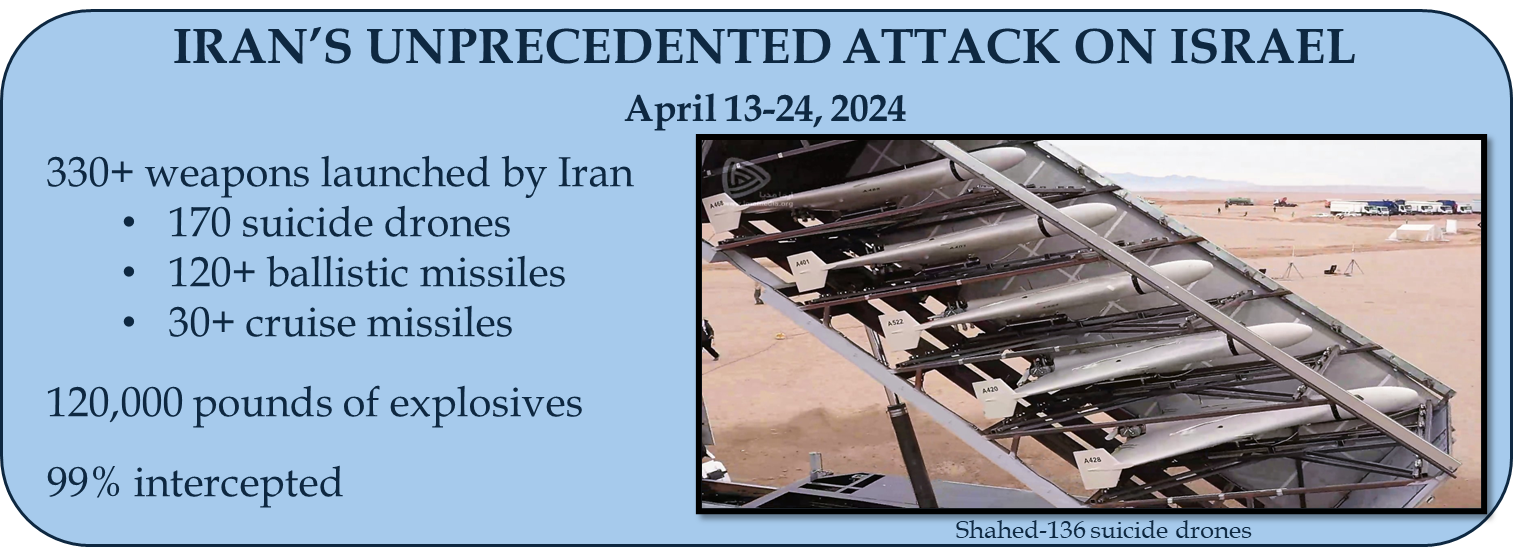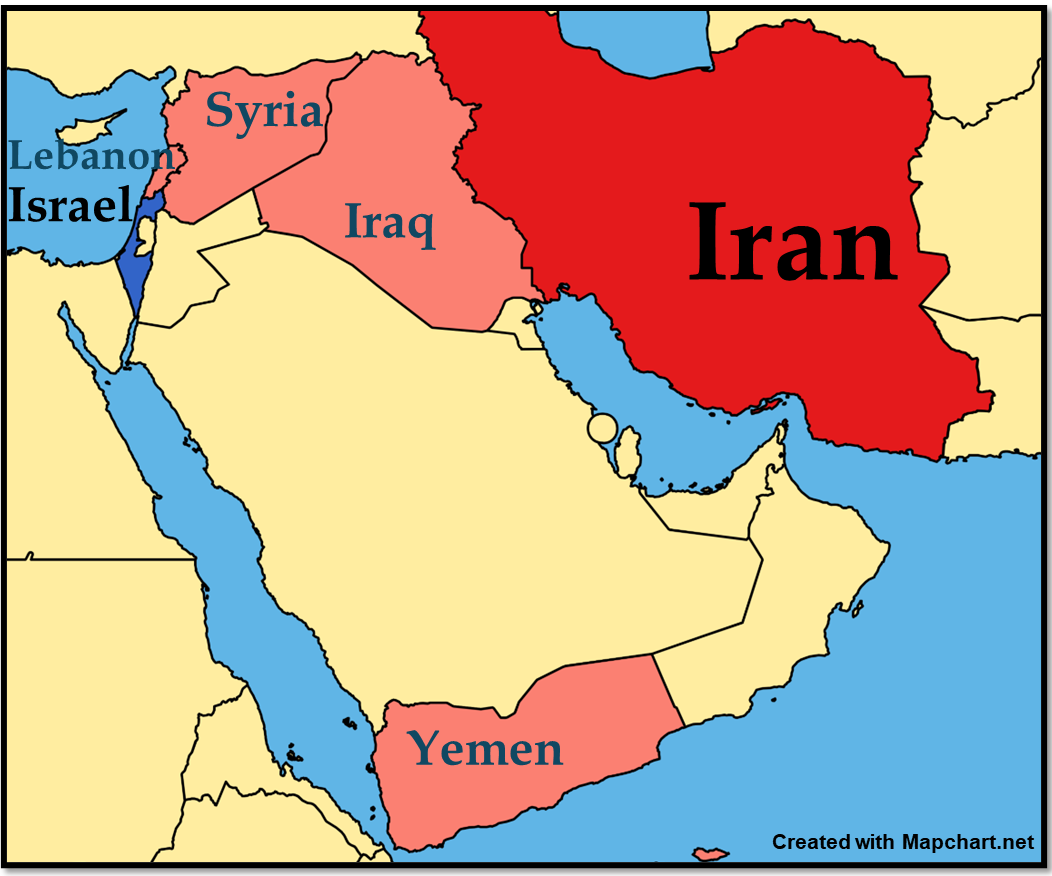Overnight on April 13-14, 2024, Iran launched an unprecedented attack—including 170 drones, at least 30 cruise missiles, and more than 120 ballistic missiles—on Israel. Iran’s militia allies in Iraq, Lebanon, Syria, and Yemen also fired rockets, missiles and drones at Israel. The swarm of assaults were retaliation for Israel’s airstrike, on April 1, on an Iranian diplomatic mission in Damascus that killed three Revolutionary Guards generals as well as other military officials. "Iran’s intent was to cause significant damage and death in Israel," Robert Wood, the U.S. ambassador, told an emergency session at the U.N. Security Council on April 14.
Israel reported that 99 percent of the weapons were shot down or intercepted before even reaching Israel, with help from U.S., Jordanian and other unnamed regional players. U.S. warplanes and sea-based air defense systems destroyed more than 80 suicide drones and at least six of the 120 ballistic missiles. John Kirby, the National Security Council strategic coordinator, called the operation a “spectacular” and “embarrassing” defeat for Iran. Iran has the largest and most diverse ballistic missile arsenal in the Middle East, but many of the systems have seldom been used in combat. Rear Admiral Daniel Hagari, the Israel Defense Forces spokesperson, said Israel’s ability to prevent potentially catastrophic damage marked “a very significant strategic success.”

Iranian leaders claimed that Operation True Promise was deliberately calibrated to avoid further escalation. It “could have been very extensive, but we limited the scope of the operation” to target the bases that Israel used to attack the Iranian consulate in Syria, Major General Hosein Salami, the commander of the Revolutionary Guards, said on April 14. But Tehran had succeeded in establishing “a new equation” in its standoff with Israel. “From now on, every attack by the Zionist regime will be met with a retaliation from the Islamic Republic of Iran,” the general warned.
The Israeli airstrike destroying an Iranian facility in Syria and Iran’s sweeping retaliation on Israel raised the stakes in their decades-long conflict, which dates back to 1982. “Even if the attack does not lead to immediate escalation, it effectively brings the Middle East into a new era,” said Paul Salem, the president and CEO of the Middle East Institute. “For the past forty years Iran has relied on a 'forward defense' strategy leaning on its militia proxies in Lebanon, then in Syria, Iraq and Yemen. Through this strategy it maintained deniability and managed to keep Iran proper out of harm's way.” The escalation in tensions “might be something Iran's current leaders end up regretting,” Salem warned.
Israel relied heavily on its three air defense systems, including Iron Dome, Arrow and David’s Sling, to counter Iranian weapons. In the build-up to tensions, the Biden administration had also deployed additional aircraft and ballistic missile defense systems both to aid Israel and defend its own forces deployed in the Middle East. “Thanks to these deployments and the extraordinary skill of our servicemembers, we helped Israel take down nearly all of the incoming drones and missiles,” President Biden said after the attack ended. The U.S. role in defending Israel against the Iranian barrage of drones and missiles reflected that “Israel is not standing alone, unlike Iran,” Kirby told reporters on April 15. He also emphasized that Washington “is not looking for a war with Iran. We’re not looking to broaden or deepen the conflict in the region.”

Iran messaged the United States during the drone and missile attack that it did not intend any further action, U.S. officials said. The use of its most important military assets—the largest since its attack on Saudi oil installations in 2019—was a serious setback both militarily and strategically. "Iran may be taking a victory lap for avenging the Damascus strike and flexing its military might, but its response could expose the limits to its offensive capabilities, given that the overwhelming majority of its weapons were intercepted," Ali Vaez, the Iran project manager of the International Crisis Group, wrote in Foreign Affairs. Tehran’s strike generated greater international sympathy for Israel and generated anger at itself, reversing public opinion after the Israeli strike on Damascus two weeks earlier, he noted.
The long-term consequences of greater international isolation—diplomatically or through economic sanctions –could also push it to deepen ties with China and Russia, Vaez wrote. Iran’s military failure may also lead it to accelerate work on other weapons. “Having failed to fend off further Israeli attacks through its regional allies and conventional weapons,” Vaez warned, “Tehran might try to use its highly advanced nuclear program to produce a nuclear weapon.
Timeline of Escalation
April 1: An Israeli airstrike killed three generals in Iran’s Revolutionary Guards and four other officers at a consulate abutting the Iranian embassy in Damascus. The attack was an unprecedented escalation in the decades-long shadow war between Israel and Iran. The precision strike, reportedly by two F-35s, targeted a meeting between Iranian officers and Palestinian militia leaders to discuss the war in Gaza.
April 13-14: Iran launched an unprecedented attack—including 170 drones, at least 30 cruise missiles, and more than 120 ballistic missiles—on Israel. Iran launched a combination of:
- Shahed-136 suicide drones
- Shahed-131 suicide drones
- Paveh Cruise missiles
- Emad ballistic missiles
- Ghadr-1 ballistic missiles
- Khaibar Shekan ballistic missiles
Iran’s militia allies in Iraq, Lebanon, Syria, and Yemen also fired rockets, missiles and drones at Israel. The Israeli military, with major help from U.S., British and Jordanian forces, demonstrated decisive superiority over Iran during the hours-long operation, with 99 percent of its weapons intercepted or shot down—some before they even entered Israeli airspace. Four ballistic missiles hit Israel’s southern Nevatim Airbase but only caused minor damage.
April 19: Israel reportedly launched overnight strikes in Iran, but the targets, weapons used, and extent of damage were unclear. Initially, U.S. officials told media that Israel had launched missiles and hit a site in Iran. But Iranian sources only reported the use of small drones. Media and officials attributed the small-scale attack to “infiltrators” rather than Israel. A senior Iranian official told Reuters that Tehran did not plan to retaliate against Jerusalem, which did not claim responsibility.
In central Isfahan province, antiaircraft defense systems downed a suspicious object resulting in explosions, Major General Abdolrahim Mousavi, the chief of Iran’s conventional military, the Artesh, told state media. Three small drones were reportedly intercepted near an air base. Hossein Dalirian, a spokesman for Iran’s civilian space agency, said that there had been “no air attack from outside” Iran’s borders. “They have only made a failed and humiliating attempt to fly quadcopters, and the quadcopters have also been shot down.”
Isfahan province is home to a major airbase, a missile production complex and nuclear research facilities. But local media reported that no damage was caused to any military or nuclear sites. The International Atomic Energy Agency (IAEA), the U.N. nuclear watchdog, confirmed that Iran’s nuclear sites were unharmed.
Separately, air defense systems in the northwestern city of Tabriz, about 500 miles away from Isfahan, fired at a “suspicious flying object.”
Also, Israel launched missiles at an air defense unit in southern Syria, according to Syrian state media.
